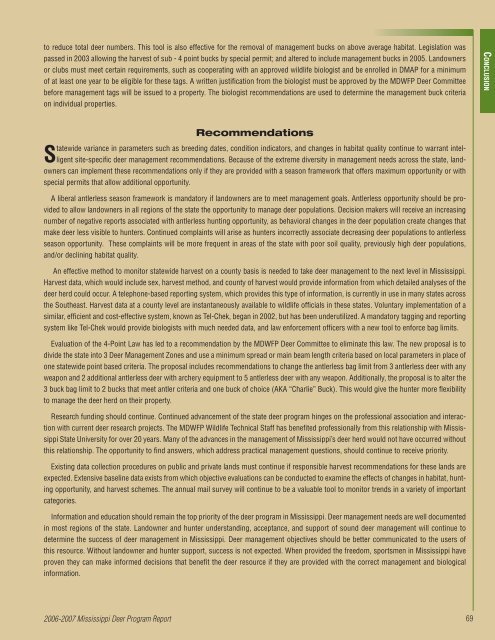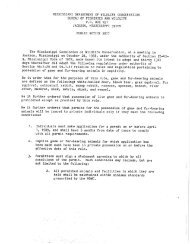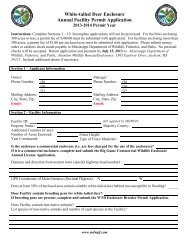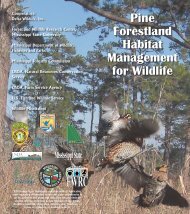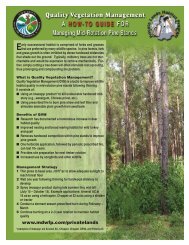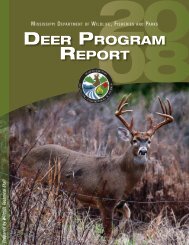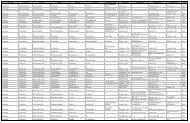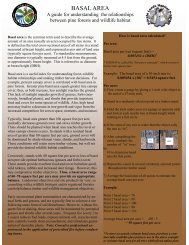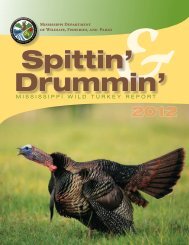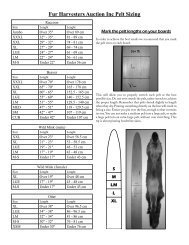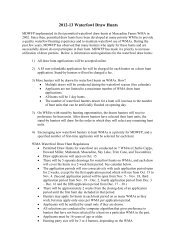DEER PROGRAM REPORT DEER ROGRAM REPORT
DEER PROGRAM REPORT DEER ROGRAM REPORT
DEER PROGRAM REPORT DEER ROGRAM REPORT
You also want an ePaper? Increase the reach of your titles
YUMPU automatically turns print PDFs into web optimized ePapers that Google loves.
to reduce total deer numbers. This tool is also effective for the removal of management bucks on above average habitat. Legislation waspassed in 2003 allowing the harvest of sub - 4 point bucks by special permit; and altered to include management bucks in 2005. Landownersor clubs must meet certain requirements, such as cooperating with an approved wildlife biologist and be enrolled in DMAP for a minimumof at least one year to be eligible for these tags. A written justification from the biologist must be approved by the MDWFP Deer Committeebefore management tags will be issued to a property. The biologist recommendations are used to determine the management buck criteriaon individual properties.Co n c l u s i o nRecommendationsStatewide variance in parameters such as breeding dates, condition indicators, and changes in habitat quality continue to warrant intelligentsite-specific deer management recommendations. Because of the extreme diversity in management needs across the state, landownerscan implement these recommendations only if they are provided with a season framework that offers maximum opportunity or withspecial permits that allow additional opportunity.A liberal antlerless season framework is mandatory if landowners are to meet management goals. Antlerless opportunity should be providedto allow landowners in all regions of the state the opportunity to manage deer populations. Decision makers will receive an increasingnumber of negative reports associated with antlerless hunting opportunity, as behavioral changes in the deer population create changes thatmake deer less visible to hunters. Continued complaints will arise as hunters incorrectly associate decreasing deer populations to antlerlessseason opportunity. These complaints will be more frequent in areas of the state with poor soil quality, previously high deer populations,and/or declining habitat quality.An effective method to monitor statewide harvest on a county basis is needed to take deer management to the next level in Mississippi.Harvest data, which would include sex, harvest method, and county of harvest would provide information from which detailed analyses of thedeer herd could occur. A telephone-based reporting system, which provides this type of information, is currently in use in many states acrossthe Southeast. Harvest data at a county level are instantaneously available to wildlife officials in these states. Voluntary implementation of asimilar, efficient and cost-effective system, known as Tel-Chek, began in 2002, but has been underutilized. A mandatory tagging and reportingsystem like Tel-Chek would provide biologists with much needed data, and law enforcement officers with a new tool to enforce bag limits.Evaluation of the 4-Point Law has led to a recommendation by the MDWFP Deer Committee to eliminate this law. The new proposal is todivide the state into 3 Deer Management Zones and use a minimum spread or main beam length criteria based on local parameters in place ofone statewide point based criteria. The proposal includes recommendations to change the antlerless bag limit from 3 antlerless deer with anyweapon and 2 additional antlerless deer with archery equipment to 5 antlerless deer with any weapon. Additionally, the proposal is to alter the3 buck bag limit to 2 bucks that meet antler criteria and one buck of choice (AKA “Charlie” Buck). This would give the hunter more flexibilityto manage the deer herd on their property.Research funding should continue. Continued advancement of the state deer program hinges on the professional association and interactionwith current deer research projects. The MDWFP Wildlife Technical Staff has benefited professionally from this relationship with MississippiState University for over 20 years. Many of the advances in the management of Mississippi’s deer herd would not have occurred withoutthis relationship. The opportunity to find answers, which address practical management questions, should continue to receive priority.Existing data collection procedures on public and private lands must continue if responsible harvest recommendations for these lands areexpected. Extensive baseline data exists from which objective evaluations can be conducted to examine the effects of changes in habitat, huntingopportunity, and harvest schemes. The annual mail survey will continue to be a valuable tool to monitor trends in a variety of importantcategories.Information and education should remain the top priority of the deer program in Mississippi. Deer management needs are well documentedin most regions of the state. Landowner and hunter understanding, acceptance, and support of sound deer management will continue todetermine the success of deer management in Mississippi. Deer management objectives should be better communicated to the users ofthis resource. Without landowner and hunter support, success is not expected. When provided the freedom, sportsmen in Mississippi haveproven they can make informed decisions that benefit the deer resource if they are provided with the correct management and biologicalinformation.2006-2007 Mississippi Deer Program Report69


